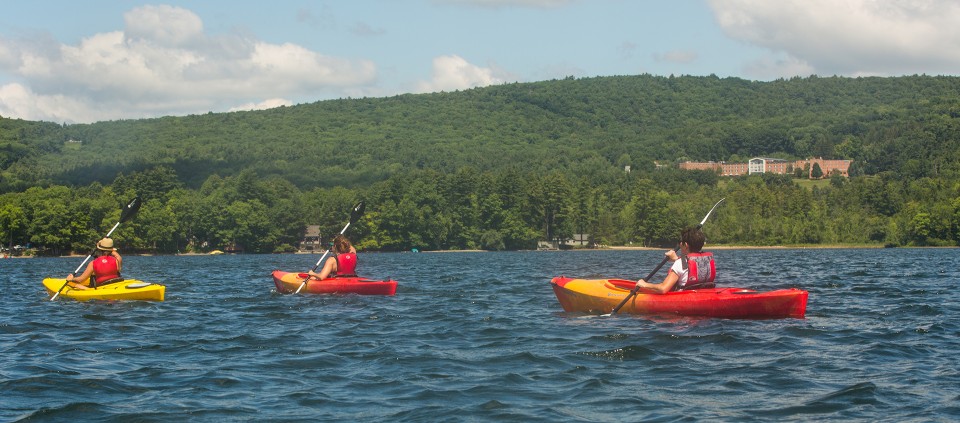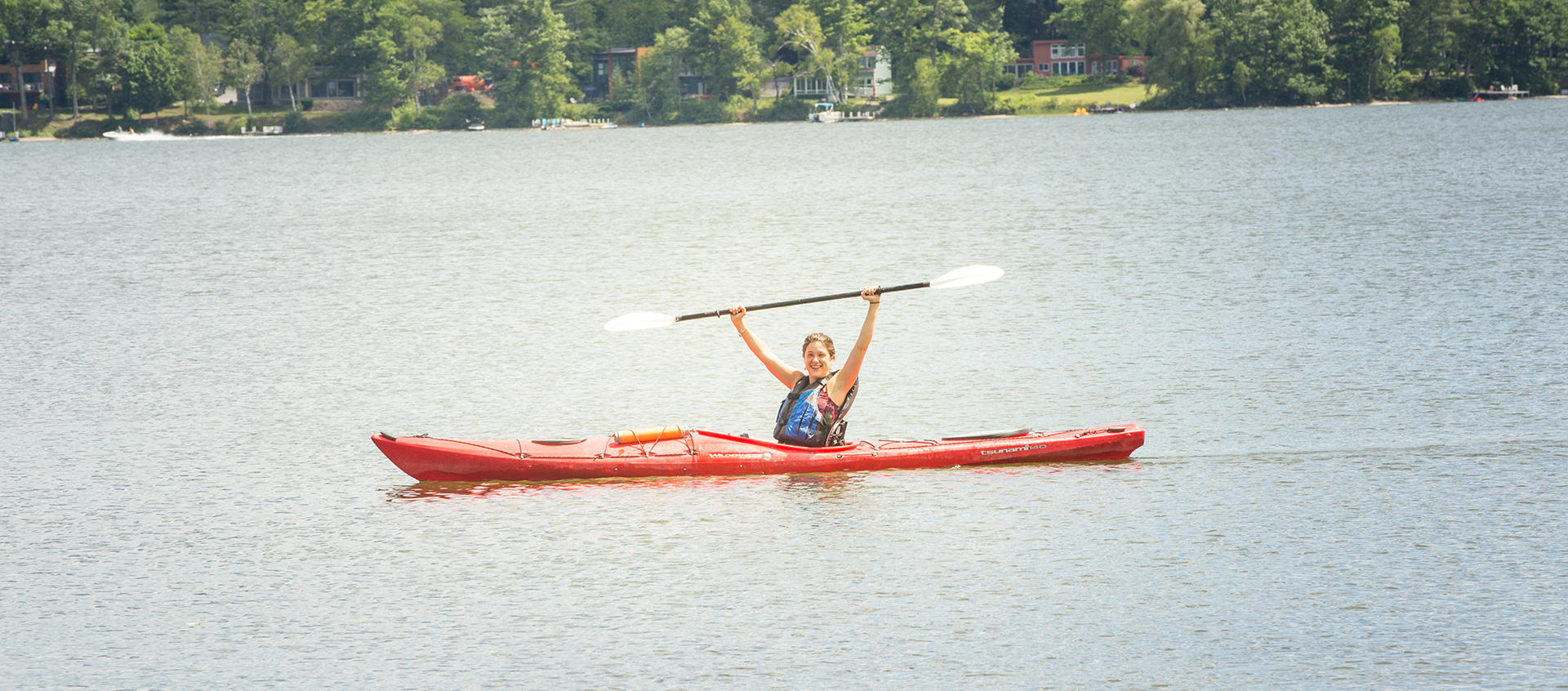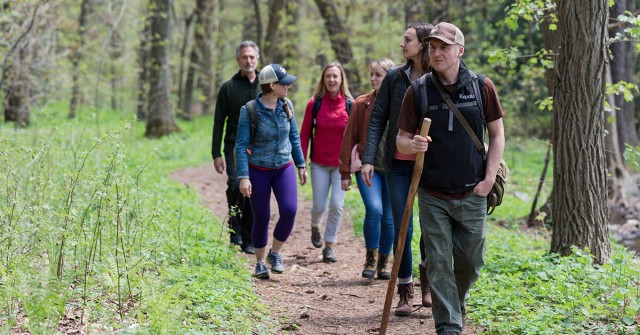My Mindful Kayaking Experience at Kripalu

by CTD Robinson
On my first trip to Kripalu, many years ago, I was so focused on finding myself and enlightenment that I never left the yoga mat. I came alone, and despite staying in a dorm room with several other people, I kept my distance and didn’t try to meet anyone. I didn’t explore the grounds or do anything new.
I came at a time of my life when I lived in fear. My intuition drew me to places like Kripalu, but my intensity didn’t help me. In fact, it brought me farther away from inner peace and genuine connection.
When I returned to Kripalu this summer for a three-day R&R with my sister, Ally, everything was different. This trip was not lived in fear, but in joy.
In the Kripalu R&R program, you can pick and choose your activities—it’s an open-ended, do-it-yourself experience. On the last afternoon of our retreat, Ally and I power-walked down to the lake for a kayaking workshop, along with two new friends we’d just met in the lobby. When we arrived at the shore, we joined a group of people clustered around a picnic table and met a Kripalu Yoga teacher and outdoor guide.
“Let me explain a few things about the kayaks,” Susan said. “You want the logo on your oar to be right-side up. Then you know it’s in the correct position. Let’s all try it.”
I brought my oar up to waist level and adjusted the paddles in the way she’d demonstrated. Everyone else did the same, and Ally flashed a smile at me. Susan continued.
“Looks good, everyone. Okay, the most common time to fall into the water in a kayak is when you’re getting in and out. Keep your gravity low, with bent knees, and you’ll be fine. I’ll stay in the front and my trusted co-leader will stay in the back. We’ll go out to the island on the lake, meditate for a bit, and come back.”
Even in her introductory talk, Susan’s matter-of-factness and confidence came through in a way that set me at ease. Although I’ve worked on it a great deal over the years, I still have anxiety. Building awareness and ownership of my anxiety are some of the best ways for me to take care of it, and of myself. Mindfulness practice, therapy, and throwing myself into unknown scenarios through travel and outdoor adventures have gotten me to where I am today. But new situations, even mindful kayaking at a yoga retreat, still bring up mild anxiety—new people, out of my control and different from my daily norm.
We headed to the edge of the lake, where the kayaks were lined up. When everyone had picked a kayak, I found one and got in, too. I adjusted the back of the seat to support my lower back, which was tender from a minor sprain a few months prior. Susan came over to help. “How does that feel? I think your knees are too high. How about we do this?” Susan said, as she moved the foot supports and tightened the backrest. “That should do it.”
As I paddled away from shore, my heart felt warmed by Susan’s help, even though I could have done it on my own. There is something wonderful about being taken care of, and inviting the care. I had missed out on that during my first trip to Kripalu.
Once we were all in our kayaks on the water, we set out for the island not far away. I floated around in the middle of the group, and tried to stay close to Ally. We shared an observation now and then, but mostly just looked at each other and smiled. Even on the water, amidst this larger group, I found myself wanting to be near my sister; the proximity brought joy and comfort.
This was our first trip away on our own as adults together. It was a good choice, as yoga and mindfulness are ways of life for both of us. The retreat setting helped me see my reactions to the world around me. I noticed small things, like how fixated I am on not touching door handles after I wash my hands in public restrooms, but also bigger things, like how much I measure what I do based on my sister’s choices. Lucky for me, she has made excellent choices in her life and ultimately led me to mindfulness. In high school, her desire to learn about Shambhala meditation brought me to two Shambhala retreats. I haven’t gone as deep in this tradition as she has, but the retreats kick-started a lifelong commitment to and exploration of mindfulness practices that have made a profound impact on my life.
As we glided along the surface of the water, I alternated between talking with Ally and other group members as they floated by. Even with the sun shining steadily, it wasn’t as humid as it can be sometimes on the East Coast. We paddled at a pace that encouraged breaks. Every now and then, I plunged my hand into the water alongside the kayak, stretching my fingers wide to let the coolness fully envelop them.
When we got to the island, we prepared for our meditation. But a lawn mower, blaring across the water from the shore to our right, had other plans. “We will look at what is around us, and notice the lawn mower,” Susan said. “I wish it wasn’t there right now, but I remember what a teacher of mine once said about unpleasant sounds like this one: Label it as unpleasant and let it go away.” Susan again took the moment into her hands to help us feel at ease.
As we meditated, I labeled that lawn mower as unpleasant at least three times. I was probably cursing at it in my head without witnessing the thoughts a bunch more times. This is where I’ve come with my mindfulness practices. I’m aware of the messiness and abundance of my thoughts. I notice what I can. I don’t notice everything. I accept these facts, let them go (sometimes), and try again.

I was given the superlative of “class worrier” in the eighth grade. The proclivity to be in my head and live in fear runs deep. I remember a moment in a meditation retreat several years ago when I realized just how frenzied, speedy, and harsh my thoughts could be. The sudden insight was overwhelming, terrifying, and nearly lead to a panic attack. Since then, I have worked to accept and be curious and compassionate towards the quality of my thought patterns. Ironically, the more I embrace my nature for what it is, the more spacious I feel. For me, spaciousness might mean cursing the lawn mower five times instead of twenty.
We all have our unique temperaments, and each and every one of them is okay. It’s how we choose to respond to them that matters. The practice of noticing brings wisdom, even—and, I’d argue, especially—in the times when we don’t notice.
As we closed our meditation and turned toward shore, two green herons flew in and out of the trees nearby. Ally pointed to another bird, this one a blue heron, as it soared over our heads and took flight across the glittering water. Its presence felt huge and weighty above our heads. We were witnesses to the rhythms of the lake. We moved through it, taking it in as much as we could, and paddled forward.
The kayaking trip was an amazing way to bring to a close a joyful, mindful retreat, which was different from my last trip in several ways. Being older and traveling with my sister were both part of the equation. A third, more difficult aspect to pinpoint made the most striking difference: the growth of my spiritual journey. For that, I have my sister, Kripalu, meditation, and yoga to thank—and my commitment to these practices. I’m not claiming to have found enlightenment, but I know that the kayaking trip—alongside my sister, under the careful, mindful guidance of Susan, held in the expanse of water and sky—was exactly what I needed.
CTD Robinson is a writer, educator, and mindfulness practitioner. She holds an MFA in creative writing from Lesley University, and is pursuing a master’s degree from the Bread Loaf School of English at Middlebury College.
